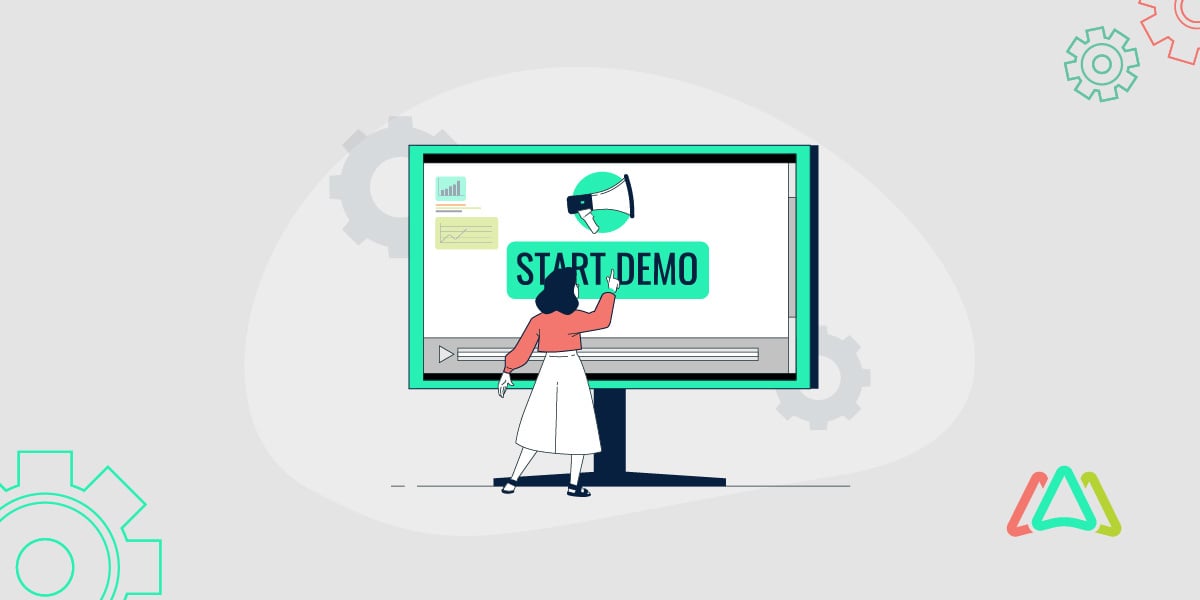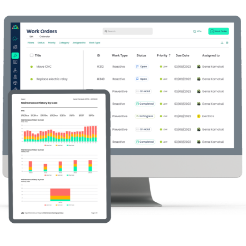
Preparing for a CMMS Demo: Vendor and Customer Perspectives
Introduction
Selecting the right Computerized Maintenance Management System (CMMS) is a critical decision for organizations aiming to improve operational efficiency. Similarly, matching customers with the right CMMS solution represents the break-point between success and failure for vendors.
For each, a well-executed CMMS demo is a vital part of this process, providing both customers and vendors an opportunity to evaluate fit, functionality, and potential for collaboration and future growth. Whether it’s an introduction to a new CMMS solution or a comparison of multiple systems, demos allow organizations to see the software in action and assess how well it meets their unique needs.
As the majority of CMMS software demos are now conducted online, demo preparation has become essential for both customers and CMMS vendors. For vendors, this means tailoring presentations to address customer pain points and showcase relevant features that meet their current and future needs. For customers, it involves defining their needs, wants, and requirements, clarifying success criteria, and providing an opportunity to compare offerings from various CMMS providers.
Here, we’ll present practical guidance on CMMS demos from both perspectives, aiming to ensure a productive and insightful experience.

Vendor Perspective
Maximizing Value for Prospects
CMMS vendors play a pivotal role in ensuring that customers get the most out of their CMMS software demo experience. Providing an in-depth demo is the best way to do so. When designing a customized demo, a key step for vendors is understanding the prospect’s business needs and pain points. By encouraging prospects to share their challenges and goals in advance, vendors can tailor the demo to highlight features that address those specific issues. For example, if a company is struggling with preventive maintenance scheduling, the demo should emphasize how the CMMS can streamline this process.
Alternatively, if a company is concerned about the overall value of a CMMS, vendors can offer case studies demonstrating the long-term benefits using KPI results. By taking these important steps, the CMMS demo will not appear “cookie-cutter” but customized to a potential customer’s needs.
Vendors should also guide prospects on how to prepare for the demo. Providing a checklist or a pre-demo questionnaire can help customers clarify their expectations. This preparation ensures that the demo is focused, efficient, and directly relevant to the prospect's needs, ultimately increasing the likelihood of moving forward in the sales process.
Demo Logistics
Most CMMS demos today are conducted via web conferencing platforms like Zoom, Microsoft Teams, or Google Meet. These tools provide a convenient and cost-effective way for vendors to showcase their software to prospects anywhere in the world. A typical CMMS demo lasts between 30 and 60 minutes, so vendors must use this time wisely by focusing on their customers’ concerns. The demo should begin with a brief overview of the software's capabilities before diving into specific use cases that align with the customer’s pain points.
Vendors often conduct an initial demo with a project lead or key decision-maker. This session is designed to establish whether the CMMS is a good fit for the organization’s needs. The demo should provide sufficient information for the potential customer to go back to company stakeholders to consider moving forward or moving on. If the initial demo is successful, follow-up sessions with additional stakeholders can be scheduled to provide a more in-depth exploration of the software's features as well as an opportunity to address additional questions not already raised. These subsequent demos allow vendors to ensure that all potential users feel confident in the system's capabilities.
Onsite Demos
While on-site CMMS demos are rare today, they still hold value in certain situations. Large, big-budget companies that prioritize long-term partnerships with CMMS providers may request an on-site demonstration to evaluate the software more comprehensively. These demos allow vendors to view their potential customers' operations upfront, interact directly with key stakeholders, and build stronger relationships.
At the same time, onsite demos come with some challenges, including higher costs and logistical complexities. Unlike web-based demos, recordings for future reference are not possible. This makes it crucial for vendors to leave a lasting impression during the session. To maximize the impact of onsite demos, vendors should prepare extensively, ensuring that the presentation is tailored to the organization’s specific goals and operational context. By providing a hands-on experience that demonstrates the software's real-world value, CMMS providers can build trust and establish themselves as reliable long-term partners.
Customer Perspective
Preparation Tips
For customers, preparing for a CMMS demo is critical to ensuring they get the information they need to make an informed decision. General information is fine, but without the details that address your needs, a demo can fall short of being beneficial. To avoid this situation, it’s essential to create a list of detailed requirements and success criteria before a scheduled demo. This list should include the specific challenges you’re facing, such as managing work orders, scheduling preventive maintenance, or gaining better insights into asset performance. A clear understanding of your goals will help you evaluate whether the CMMS providers you're considering can address your organization’s unique needs.
Additionally, customers should share their requirements with the CMMS vendor ahead of time. This allows the vendor to tailor the demo to focus on the features and functionalities that matter most to your team. During the demo, ensure you’re asking targeted questions that align with your success criteria. For example, if your primary goal is reducing downtime, inquire about the system’s predictive maintenance capabilities. Being proactive in the demo will help you determine if the software is a good fit for your organization.
Evaluating Vendors
Choosing the right CMMS provider often requires reviewing demos from multiple vendors. Ideally, customers should schedule demos with 3 to 5 CMMS providers to compare their offerings and get a sense of what an ongoing relationship will be like. This approach provides a broader perspective on what the market offers and ensures they don’t settle for the first solution they see. Each demo should be evaluated based on how well the software aligns with their requirements, solves their pain points, and supports their long-term maintenance goals.
As you review multiple CMMS demos, consider the software's functionality and the level of customer support and training provided by the vendor. A feature-rich CMMS is only as effective as its implementation, usability, and support. Ask vendors about onboarding processes, training programs, and ongoing support to ensure their solution will deliver value beyond the demo.
Taking the time to evaluate and compare vendors thoroughly can prevent costly mistakes and help you choose a CMMS that drives sustainable success for your organization.
Best Practices for Both Parties
For CMMS demos to be truly successful, vendors and customers must collaborate on the process. Given the cost, resources, and time associated with a CMMS purchase, vendors and customers need to feel confident that the solution being considered can do the job.
As such, CMMS vendors should ensure their demos are tailored to address the customer’s specific needs. This means investing time in understanding the customer’s pain points and aligning the demo content with their goals. A generic, feature-dense presentation risks overwhelming prospects and missing the opportunity to demonstrate how the software solves real-world challenges. Instead, vendors should highlight scenarios directly related to the customer's industry, whether it’s manufacturing, healthcare, or another sector.
Similarly, customers need to take an active role during the demo. This involves asking detailed questions, providing feedback, and being transparent about their operational challenges. For example, if a customer is struggling with compliance tracking, they should ask the CMMS provider to demonstrate how the software handles regulatory requirements. By fostering an open dialogue, customers can gain deeper insights into how the system functions and whether it aligns with their success criteria.
Both parties should view the demo as an opening conversation about a long-term partnership. CMMS providers who go the extra mile to customize their presentation and address specific customer concerns are more likely to build trust and credibility. At the same time, customers who approach the demo with a clear understanding of their needs and an openness to exploring solutions will find it easier to identify the right provider. This collaborative approach ensures that the demo is not just a sales pitch but a meaningful step toward a mutually beneficial relationship.
Conclusion
A successful CMMS demo goes a lot further than simply showcasing its features—it’s a collaborative process that lays the foundation for a strong long-term vendor-customer relationship. By approaching the demo strategically, CMMS vendors can demonstrate their software’s ability to solve real-world challenges and meet specific customer needs. Meanwhile, customers who clearly define their goals, requirements, and pain points are in a better position to assess how well a CMMS provider aligns with their operational priorities.
Whether you’re a CMMS provider delivering a web-based demo or a customer evaluating multiple CMMS vendors, preparation and open communication are pivotal in maximizing the value of the demo experience. A well-executed CMMS software demo helps customers choose the best solution and also enables vendors to build trust and credibility in a competitive market. By prioritizing collaboration and focusing on each organization's unique needs, both parties can ensure a demo process that drives their respective long-term success.
TABLE OF CONTENTS
Keep Reading
Last month, news outlets and the entire internet was abuzz with the return of NASA astronauts ...
3 Apr 2025
What comes first - CMMS or predictive maintenance? If your answer is either, it is correct. ...
28 Mar 2025
Artificial intelligence (AI) talk has become commonplace. Today, engaging in business-focused ...
27 Mar 2025
Imagine a world where machines predict, diagnose, and fix their issues before they fail. This ...
25 Mar 2025
A facility maintenance plan is at the core of a facility’s operations. This organized ...
21 Mar 2025
Think of managing your maintenance operations like managing a championship sports team. Just ...
21 Mar 2025
The maintenance sector is battling a severe talent shortage that threatens to undermine ...
7 Mar 2025
Manufacturing maintenance is the backbone of industrial efficiency, ensuring machines run ...
5 Mar 2025
No one likes playing a guessing game when equipment breaks down. Yet, maintenance teams often ...
4 Mar 2025
The size of the preventive maintenance software market is discussed in millions of dollars, ...
4 Mar 2025
The organizational structure and corporate hierarchy vary from company to company. Large ...
28 Feb 2025
Maintenance procedures are essential for ensuring the longevity and reliability of machinery ...
21 Feb 2025
Sustainability is no longer just a buzzword; it's a critical component of corporate social ...
20 Feb 2025
A Computerized Maintenance Management System (CMMS) relies on accurate, well-organized data ...
18 Feb 2025
In an era where technology drives operational efficiency, Computerized Maintenance Management ...
14 Feb 2025
A Computerized Maintenance Management System (CMMS) is a key component of modern maintenance ...
13 Feb 2025
Introduction Maintenance management is the foundation of maintenance operations in industries ...
11 Feb 2025
Introduction A Computerized Maintenance Management System (CMMS) is software designed to help ...
7 Feb 2025
Introduction Due to a growing awareness of the need to combat climate change, the green ...
6 Feb 2025
When your organization decides to invest in a CMMS (Computerized Maintenance Management ...
4 Feb 2025





